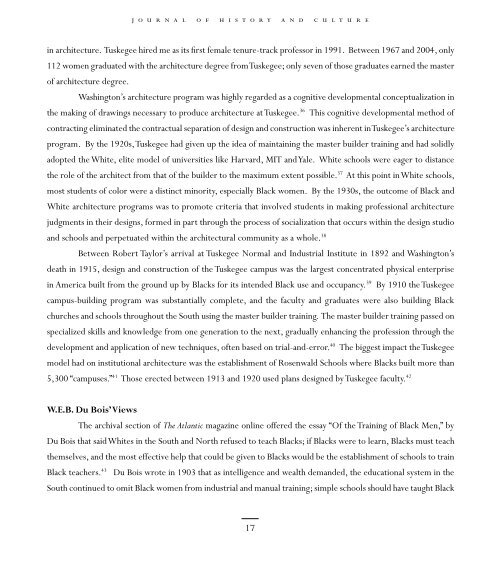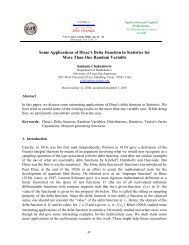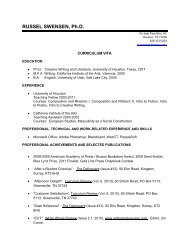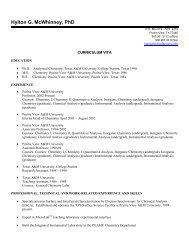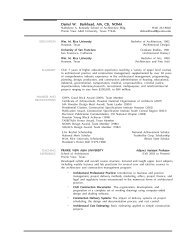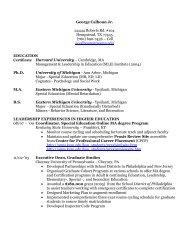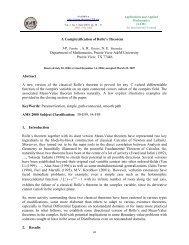Journal of History and Culture Journal of History and Culture
Journal of History and Culture Journal of History and Culture
Journal of History and Culture Journal of History and Culture
Create successful ePaper yourself
Turn your PDF publications into a flip-book with our unique Google optimized e-Paper software.
j o u r n a l o f h i s t o r y a n d c u l t u r e<br />
in architecture. Tuskegee hired me as its first female tenure-track pr<strong>of</strong>essor in 1991. Between 1967 <strong>and</strong> 2004, only<br />
112 women graduated with the architecture degree from Tuskegee; only seven <strong>of</strong> those graduates earned the master<br />
<strong>of</strong> architecture degree.<br />
Washington’s architecture program was highly regarded as a cognitive developmental conceptualization in<br />
the making <strong>of</strong> drawings necessary to produce architecture at Tuskegee. 36 This cognitive developmental method <strong>of</strong><br />
contracting eliminated the contractual separation <strong>of</strong> design <strong>and</strong> construction was inherent in Tuskegee’s architecture<br />
program. By the 1920s, Tuskegee had given up the idea <strong>of</strong> maintaining the master builder training <strong>and</strong> had solidly<br />
adopted the White, elite model <strong>of</strong> universities like Harvard, MIT <strong>and</strong> Yale. White schools were eager to distance<br />
the role <strong>of</strong> the architect from that <strong>of</strong> the builder to the maximum extent possible. 37 At this point in White schools,<br />
most students <strong>of</strong> color were a distinct minority, especially Black women. By the 1930s, the outcome <strong>of</strong> Black <strong>and</strong><br />
White architecture programs was to promote criteria that involved students in making pr<strong>of</strong>essional architecture<br />
judgments in their designs, formed in part through the process <strong>of</strong> socialization that occurs within the design studio<br />
<strong>and</strong> schools <strong>and</strong> perpetuated within the architectural community as a whole. 38<br />
Between Robert Taylor’s arrival at Tuskegee Normal <strong>and</strong> Industrial Institute in 1892 <strong>and</strong> Washington’s<br />
death in 1915, design <strong>and</strong> construction <strong>of</strong> the Tuskegee campus was the largest concentrated physical enterprise<br />
in America built from the ground up by Blacks for its intended Black use <strong>and</strong> occupancy. 39 By 1910 the Tuskegee<br />
campus-building program was substantially complete, <strong>and</strong> the faculty <strong>and</strong> graduates were also building Black<br />
churches <strong>and</strong> schools throughout the South using the master builder training. The master builder training passed on<br />
specialized skills <strong>and</strong> knowledge from one generation to the next, gradually enhancing the pr<strong>of</strong>ession through the<br />
development <strong>and</strong> application <strong>of</strong> new techniques, <strong>of</strong>ten based on trial-<strong>and</strong>-error. 40 The biggest impact the Tuskegee<br />
model had on institutional architecture was the establishment <strong>of</strong> Rosenwald Schools where Blacks built more than<br />
5,300 “campuses.” 41 Those erected between 1913 <strong>and</strong> 1920 used plans designed by Tuskegee faculty. 42<br />
W.E.B. Du Bois’ Views<br />
The archival section <strong>of</strong> The Atlantic magazine online <strong>of</strong>fered the essay “Of the Training <strong>of</strong> Black Men,” by<br />
Du Bois that said Whites in the South <strong>and</strong> North refused to teach Blacks; if Blacks were to learn, Blacks must teach<br />
themselves, <strong>and</strong> the most effective help that could be given to Blacks would be the establishment <strong>of</strong> schools to train<br />
Black teachers. 43 Du Bois wrote in 1903 that as intelligence <strong>and</strong> wealth dem<strong>and</strong>ed, the educational system in the<br />
South continued to omit Black women from industrial <strong>and</strong> manual training; simple schools should have taught Black<br />
17


